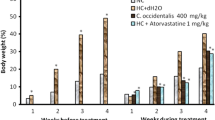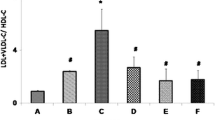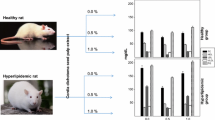Abstract
Sterol esters are currently gaining importance because of their recent recognition and application in the food and nutraceutical industries. Phytosterol esters have an advantage over phytosterols, naturally occurring antioxidants, with better fat solubility and compatibility. Antioxidants and hypocholesterolemic agents are known to reduce hypercholesterolemic atherosclerosis. The objective of the study was to determine the effects of different sterol esters on cardiac and aortic lipid profile and oxidative stress parameters and on the development of atherosclerosis in rats fed a high-cholesterol diet. Thirty six rats were divided into six groups: control group, hypercholesterolemic group and four experimental groups fed with EPA-DHA rich sitosterol ester in two different doses, 0.25 g/kg body wt/day and 0.5 g/kg body wt/day, and ALA rich sitosterol ester in two different doses, 0.25 g/kg body wt/day and 0.5 g/kg body wt/day. The sterol esters were gavaged to the rats once daily for 32 days. The cardiac and aortic total cholesterol, non-HDL cholesterol and triglyceride level which were elevated in hypercholesterolemia were significantly lowered by both the doses of sterol esters. Antioxidant enzyme activities were significantly decreased and peroxidation product, malondialdehyde was increased in hypercholesterolemia. But administration of both the sterol esters was able to increase enzyme activities and decrease MDA level in the tissues. Histological study of cardiac tissues showed fatty changes in hypercholesterolemic group which was reduced by treatment with sterol esters. The higher doses of sterol-ester caused better effects against hypercholesterolemic atherosclerosis.





Similar content being viewed by others
References
Aebi H (1984) Catalase in vitro. Meth Enzymol 105:121–126
Castro SD, Angelantonio ED, Celotto A, Fiorelli M, Passaseo I, Papetti F, Caselli S, Marcantonio A, Cohen A, Pandian N (2009) Short-term evolution (9 months) of aortic atheroma in patients with or without embolic events: a follow-up transoesophageal echocardiographic study. Eur J Echocardio 10:96–102
Chang AN, Chang CP, Chou YC, Huang KY, Hu HH (1999) Differential disturbance of apolipoprotein E in young and aged spontaneously hypertensive and stroke-prone rats. J Hypertens 17:793–800
Chen LC, Boissonnneault G, Hayek MG, Chow CK (1993) Dietary fat effects on hepatic lipid peroxidation and enzymes of H2O2 metabolism and NADPH generation. Lipids 28:657–662
Cheon HG, Cho YS (2014) Protection of palmitic acid-mediated lipotoxicity by arachidonic acid via channeling of palmitic acid into triglycerides in C2C12. J Biomed Sci 21:13
Clarke SD (2001) Polyunsaturated fatty acid regulation of gene transcription: a molecular mechanism to improve the metabolic syndrome. J Nutr 31:1129–1132
Demonty I, Ebine N, Jia X, Jones PJ (2005) Fish oil fatty acid esters of phytosterols alter plasma lipid but not red cell fragility in hamsters. Lipids 40:695–702
Demonty I, Chan YM, Pelled D, Jones PJH (2006) Fish-oil esters of plant sterols improve the lipid profile of dyslipidemic subjects more than do fish-oil or sunflower oil esters of plant sterols. Am J Clin Nutr 84:1534–1542
Devi GS, Prasad MH, Saraswathi I, Raghu D, Rao DN, Reddy PP (2000) Free radicals antioxidant enzymes and lipid peroxidation in different types of leukemias. Clin Chim Acta 293:53–62
Duval C, Chinetti G, Trottein F, Fruchart JC, Staels B (2002) The role of PPARs in atherosclerosis. Trends Mol Med 8:422–430
Edem DO (2009) Haematological and histological alterations induced in rats by palm oil-containing diets. Eur J Scien Res 32(3):405–418
Ellman GL (1959) Tissue sulfhydryl groups. Arch Biochem Biophys 82:70–77
Ewart HS, Cole LK, Kralovec J, Layton H, Curtis JM, Wright JL, Murphy MG (2002) Fish oil containing phytosterol esters alters blood lipid profiles and left ventricle generation of thromboxane A2 in adult Guinea pigs. J Nutr 132:1149–1152
Flohe L, Gunzler WA (1984) Assay of glutathione peroxidase. Meth Enzymol 105:114–121
Folch J, Ascoli I, Lees M, Meath JA, LeBaron N (1951) Preparation of lipid extracts from brain tissue. J Biol Chem 191:833–841
Gylling H, Meittinen TA (1999) Cholesterol reduction by different plant stanol mixtures and with variable fat intake. Metabolism 48:575–80
Hallikainen MA, Sarkkinen ES, Gylling H, Erkkila AT, Uusitupa MI (2000) Comparison of the effects of plant sterol esters and plant stanol ester-enriched margarines in lowering serum cholesterol concentrations in hypercholesterolemic subjects on a low-fat diet. Eur J Clin Nutr 54:715–25
Hunter JE (1990) n-3 fatty acids from vegetable oils. Am J Clin Nutr 51:809–814
Jones PJ (1999) Cholesterol lowering action of plant sterols. Curr Atheroscler Rep 1:230–5
Jones PJ, Demonty I, Chan YM, Herzog Y, Pelled D (2007) Fish-oil esters of plant sterols differ from vegetable-oil esters in triglyceride lowering, carotenoids bioavailability and impact on plasminogen activator inhibitor-1 (PA-1) concentrations in hypercholesterolemic subjects. Lipids Health Dis 6:28
Lottenberg AM, Nunes VS, Nakandakare ER, Neves M, Bernik M, Lagrost L, dos Santos JE, Quintão E (2003) The human cholesteryl ester transfer protein 1405 V polymorphism is associated with plasma cholesterol concentration and its reduction by dietary phytosterol esters. J Nutr 133:1800–5
Lowry OH, Roesborough MJ, Farr AL, Randall RJ (1951) Protein measurement with Folin-Phenol reagent. J Biol Chem 193:265–275
Martin JP, Dailey M, Sugarman E (1987) Negetive and positive assays of superoxide dismutase based on haematoxylin autoxidation. Arch Biochem Biophys 255:329–36
Nenseter MS, Drevon CA (1996) Dietary polyunsaturates and peroxidation of low density lipoprotein. Curr Opin Lipidol 7:8–13
Newby LK, LaPointe NM, Chen AY, Kramer JM, Hammill BG, DeLong ER, Muhlbaier LH, Califf RM (2006) Long term adherence to evidence-based secondary prevention therapies in coronary artery disease. Circulation 113:203–12
Niehaus WG, Samuelsson B (1968) Formation of malonaldehyde from phospholipid arachidonate during microsomal lipid peroxidation. Eur J Biochem 6:126
Plat J, Mensink RP (2000) Vegetable oil based versus wood based stanol ester mixtures: effects on serum lipids and haemostatic factors in non-hypercholesterolemic subjects. Atherosclerosis 148:101–12
Prasad K, Kalra J (1993) Oxygen free radicals and hypercholesterolemic atherosclerosis: effect of Vitamin E. Am Heart J 125:958–973
Prasad K, Kalra J, Lee P (1994) Oxygen free radicals and hypercholesterolemic atherosclerosis: effect of prubucol. Int J Angiol 3:100–112
Prasad K, Mantha SV, Kalra J, Kapoor R, Kamalaranjan BRC (1997a) Purpurogallin in the retardation of hypercholesterolemic atherosclerosis. Int J Angiol 6:157–166
Prasad K, Mantha SV, Muir AD, Westcott ND (1997b) Reduction of hypercholesterolemic atherosclerosis by CDC-flaxseed with very low alpha-linolenic acid. Atherosclerosis 132:69–76
Russell JC, Ewart HS, Kelly SE, Kralovec J, Wright JL, Dolphin PJ (2002) Improvement of vascular dysfunction and blood lipids of insulin-resistant rats by a marine oil-based phytosterol compound. Lipids 37:147–152
Sengupta A, Ghosh M (2010) Modulation of platelet aggregation, haematological and histological parameters by structured lipids on hypercholesterolemic rats. Lipids 45:393–400
Sengupta A, Pal M, SilRoy S, Ghosh M (2010) Comparative study of sterol ester synthesis using Thermomyces lanuginosus lipase in stirred tank and packed bed bioreactors. J Am Oil Chem Soc 87:1019–1025
Steinberg D (1992) Antioxidants in the prevention of human atherosclerosis. Circulation 85:2338–2345
Yamamoto Y, Sakata N, Meng J, Sakamoto M, Noma A, Maeda I, Okamoto K, Takebayashi S (2002) Possible involvement of increased glycoxidation and lipid peroxidation of elastin in atherogenesis in haemodialysis patients. Nephrol Dial Transplant 17:630–636
Yoo HY, Chang MS, Rho HM (1999) Induction of the rat Cu/Zn superoxide dismutase gene through the peroxisome proliferator-responsive element by arachidonic acid. Gene 234:87–91
Acknowledgements
Financial support of University Grants Commission is gratefully acknowledged by authors.
Author information
Authors and Affiliations
Corresponding author
Rights and permissions
About this article
Cite this article
Sengupta, A., Ghosh, M. Reduction of cardiac and aortic cholesterol in hypercholesterolemic rats fed esters of phytosterol and omega-3 fatty acids. J Food Sci Technol 52, 2741–2750 (2015). https://doi.org/10.1007/s13197-014-1346-2
Revised:
Accepted:
Published:
Issue Date:
DOI: https://doi.org/10.1007/s13197-014-1346-2




